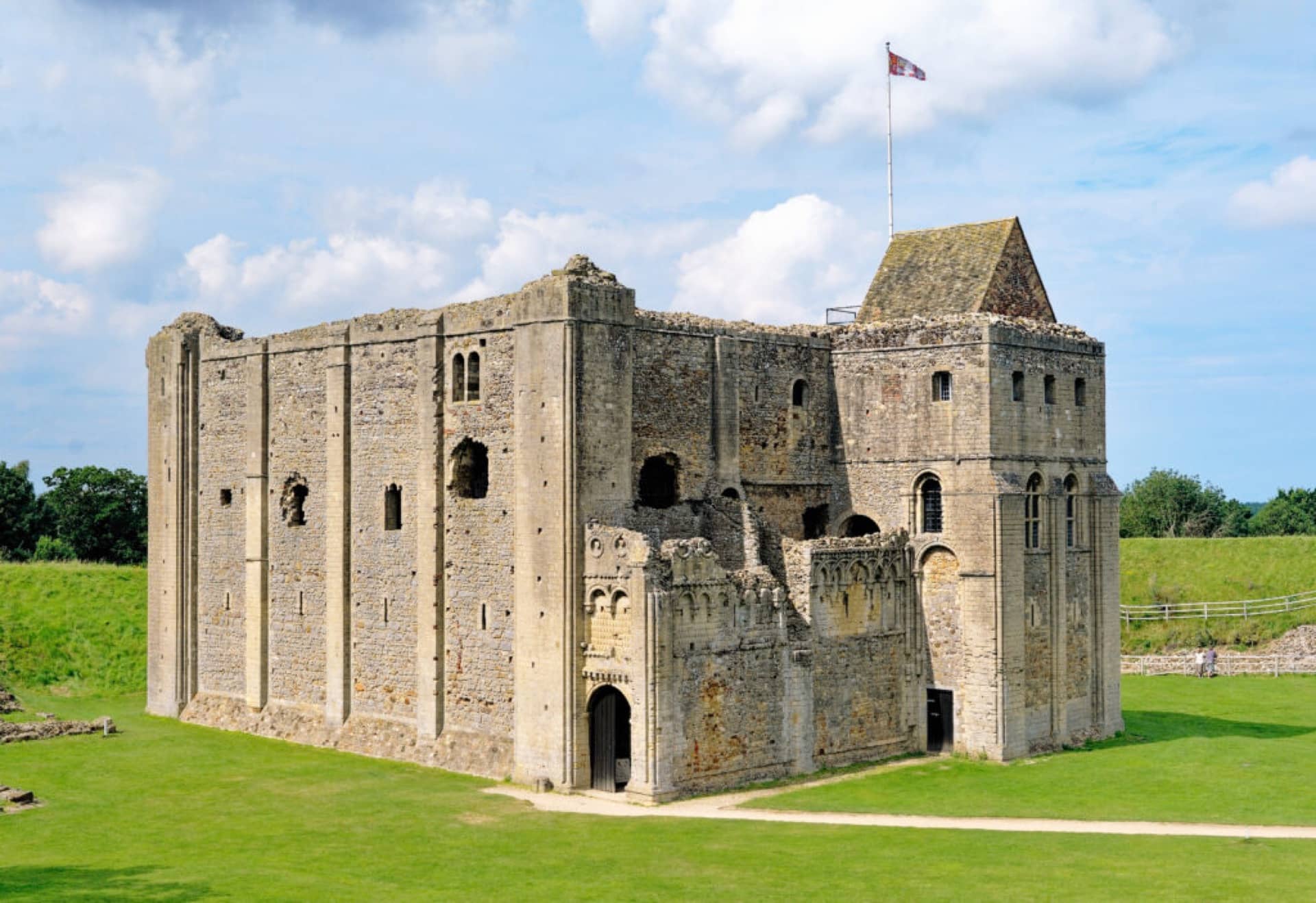
Rising Chase
Castle Rising emerges from the Norfolk landscape brimming with ancient tales of royal scandal and political intrigue. Sited on impressive earthworks, this famous 12th century Norman fortification was once home to the She-Wolf, one of the most notorious queens in history. Isabella of France, spurned wife of Edward II, briefly took the throne with her lover, forever suspected of her husband’s brutal murder. Eventually her son, teenage King Edward III, had his mother’s lover hanged and Isabella put under (rather luxurious) house arrest at Castle Rising. Families eh?
The Great Hall once saw nights of feasting, hounds jostling for scraps under tables laden with venison, roasted swan and peacock, pastries, cheeses, fruit, honey and er…turnips. Well what did you expect in the Middle Ages, smashed avocado? Meat was cut with daggers and eaten from greasy fingers washed in water scented with lavender, hyssop, sage and roses while minstrels and jesters entertained guests as the stone walls flickered with firelight.
Climb the castle mound for magnificent 360° views. Imagine the rising of the sun and the running of the deer, for once a great hunting chase, the preserve of the nobility, circled these fields. Its traces are still imprinted on the land today.
On stormy nights, it’s said the wild laughter of the long dead She-Wolf is still heard howling in the wind as her ghost stalks the church ruins, clutching the beating heart of her murdered husband.

Warham Camp, Norfolk’s Iron Age Hill Fort
At a bend of the River Stiffkey, Iceni workers were sweating and cursing as they shifted huge mounds of earth using only simple hand tools. They were building fortifications for defence. Over 2,000 years later, their fort is still here, known as Warham Camp. Its exact purpose is unknown. Perhaps it was a place of ceremony or the residence of a high status leader. The Iceni tribe were led most famously by Boudica, the Celtic warrior queen, famed for battling Anglia’s Roman occupiers. Imagine Iceni guards, patrolling the wooded palisade looking out for Roman military columns on the march. Archaeological evidence tells us the Romans once occupied this fort; what history passed in this ancient place?
Warham Camp is Norfolk’s best preserved Iron Age hill fort, a scheduled monument and also a Site of Special Scientific Interest (SSSI). It’s mind-blowing to think of the people who made this spectacular 212m circular earthwork before the days of mechanical machinery. The views across the fields towards the coast are equally awe-inspiring. Look carefully at the land. You might notice the remains of ridge and furrow. Their age is uncertain, though characteristic of the medieval period. Part of the earthworks was destroyed in the mid-18th century, when the south-western curve of the monument was levelled to improve the view from nearby Warham Grove House and to straighten the course of the river Stiffkey. Year round, it’s a peaceful, beautifully evocative place for a thought-provoking walk.
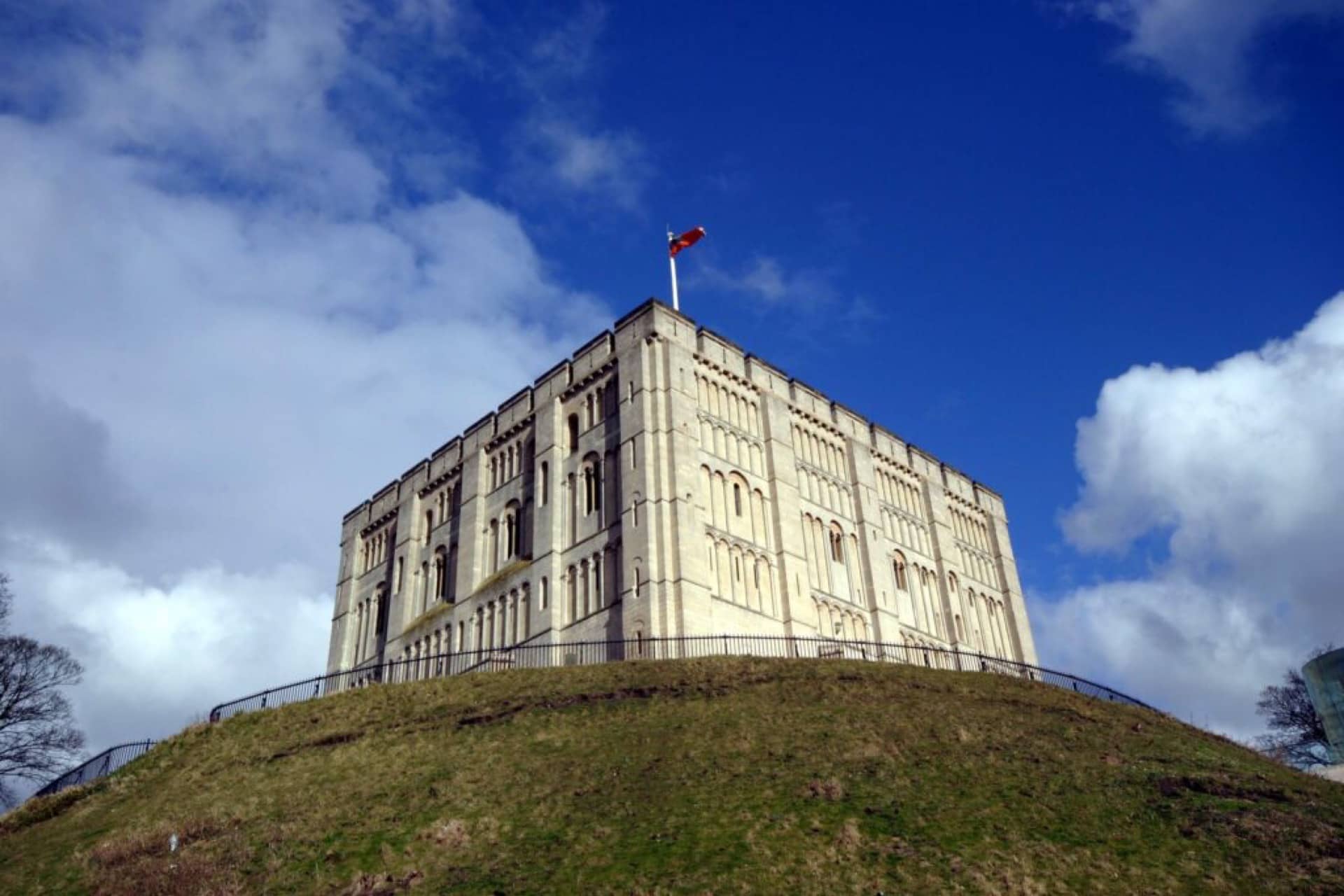
The King Under the Castle
When Albion has need of him, King Arthur will return. So says Arthurian legend. But Norfolk has its own stories. Local folklore tells of a great king who loved Norfolk so well he built a Fine City, long before the days of the Romans. All hail King Gurgunt! Gurgunt rests in enchanted sleep, sword in hand, deep below the green mound of Norwich Castle, until he rises again to save his beloved land.
Norwich Castle should be one of everyone’s top ten days out in Norfolk. Now a museum, it’s full of natural, social and fashion history alongside important artworks. And, as it’s been both a castle and prison, there are plenty of ghosts, most of them friendly!
Heroes like Gurgunt have roamed the English imagination and landscape since time beyond memory. You could substitute England with many other places, for similar archetypal myth cycles echo across the world. Tales of a King Under the Mountain existed long before being summoned by Tolkien, the recurring motif of a messianic leader who will return at a time of great peril. King Gurgunt resurfaced when Queen Elizabeth I visited Norwich during her royal progress in 1578. It’s said the mythical King stepped from the crowd as if to speak with her. Alas, a violent shower of rain made the queen run for shelter, and Gurgunt never delivered his message. Ancient spirit whose words might have changed the course of history, or Tudor actor whose prank was thwarted by the weather? You decide!
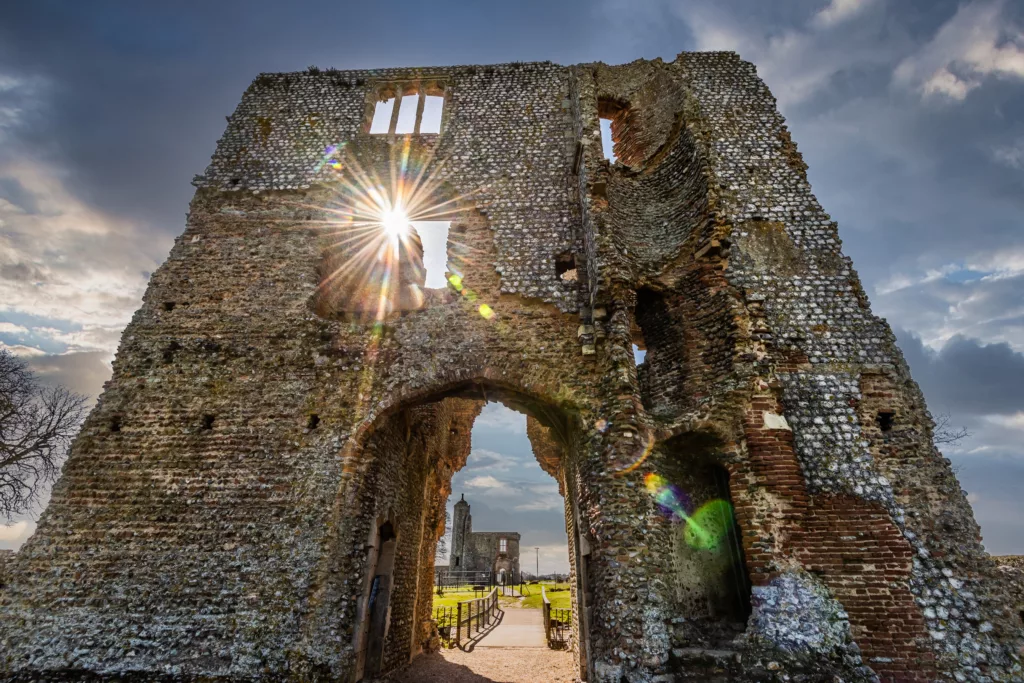
Baconsthorpe Castle: A Woolly Tale
Let’s spin a yarn. It’s 1450 and thousands of sheep graze Norfolk’s purple heathlands. The wool trade is booming all over Europe and ambitious Norfolk lawyer John Heydon is determined to have a piece of it. Crafty deals soon make the Heydons major players, keen to flash their cash by splashing out on an imposing fortified manor house, complete with moat. Serious medieval bling.
By the mid-16th century, the castle ‘factory’ was turning raw fleeces into fine cloth in a workshop at the east end, flooded with dawn light from impressive windows. Spinners and weavers toiled over textiles sold in England and the Netherlands. Great wealth followed. In the 1560s, Sir Christopher Heydon had 80 servants, 2 coaches and fabulous parties, entertaining 30 head-shepherds at Christmas in thanks for tending 30,000 sheep.
Alas…lavish living collided with tumbling wool markets and Christopher died in debt. But the Heydons carried on spending, now more interested in astrology than business. Then Sir John Heydon III, a Royalist, was declared delinquent by Parliament in the English Civil War. And by the mid-17th century insurmountable debts forced the family to demolish most of the castle and sell off the materials. But the banqueting hall’s stained glass Heydon shields were salvaged. You can see them today in the south aisle windows of Baconsthorpe Church.
And all that’s left of the castle are ruins, left by a family that made and lost a fortune. Still, they’re a pretty place for a picnic on a golden autumn day.
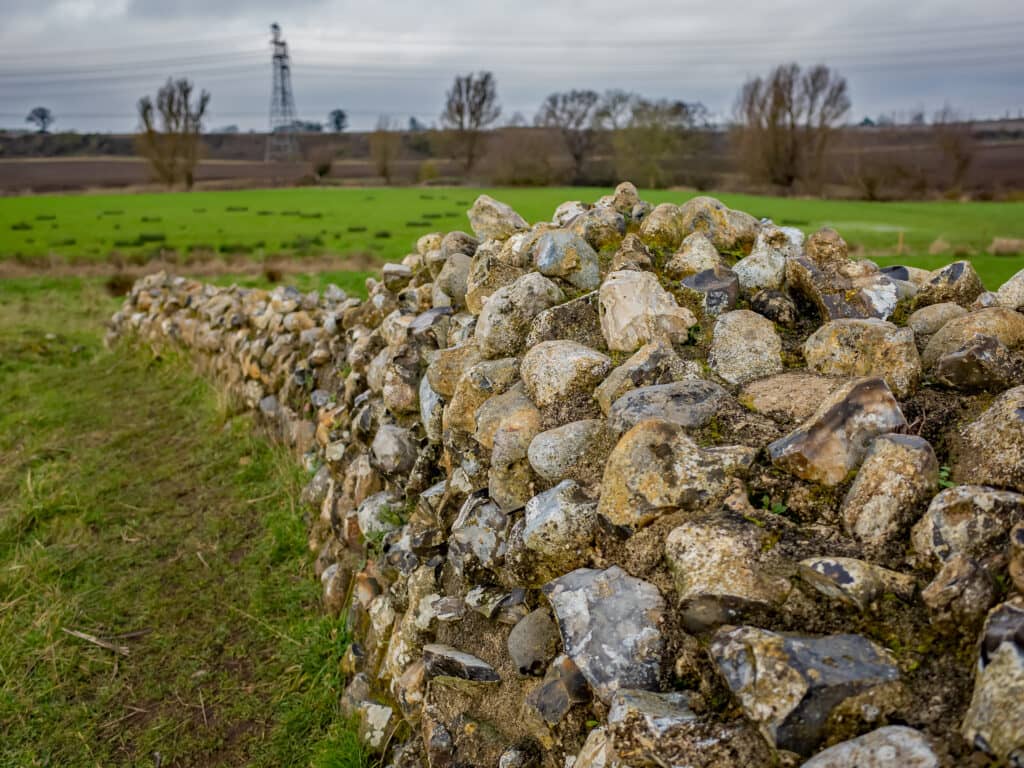
Caistor Roman Fort
Imagine summoning up an outpost of Ancient Rome in modern Norfolk…
With the free Caistor Roman Town Augmented Reality app you can time travel to Venta Icenorum, once the largest Roman town in East Anglia built in Iceni territory after Boudicca’s doomed rebellion. Life was comfortably sophisticated in this elegant settlement, established in AD70. Arranged in a grid of streets, facilities included running water, an amphitheatre, temples, baths, a town hall (basilica) and central public meeting place (forum). Archaeological excavations have revealed remains of inkwells, styli and graffiti, suggesting the 2,000 residents had international links and a high degree of literacy.
On a clear, fresh autumn day, climb up to the circular embankment. The town wasn’t enclosed at first, with the banks and walls visible today built in the 3rd century AD. Standing under Norfolk’s beautiful big skies you get a fantastic sense of the vantage point used by Roman guards scanning the vast rolling landscape for enemies, or perhaps friends! Using the app, look down into the settlement area to experience the town and its everyday objects brought to life.
Following the fall of the Roman Empire the market town began to decay, finally abandoned in the 8th century when Norwich became the county’s main civic settlement. Little Roman masonry still stands at the encampment – although a walk around today’s village of Caistor St Edmund gives you a clue as to where it went!
Download the app before heading to Caistor St Edmund. Watch a sneak preview here.
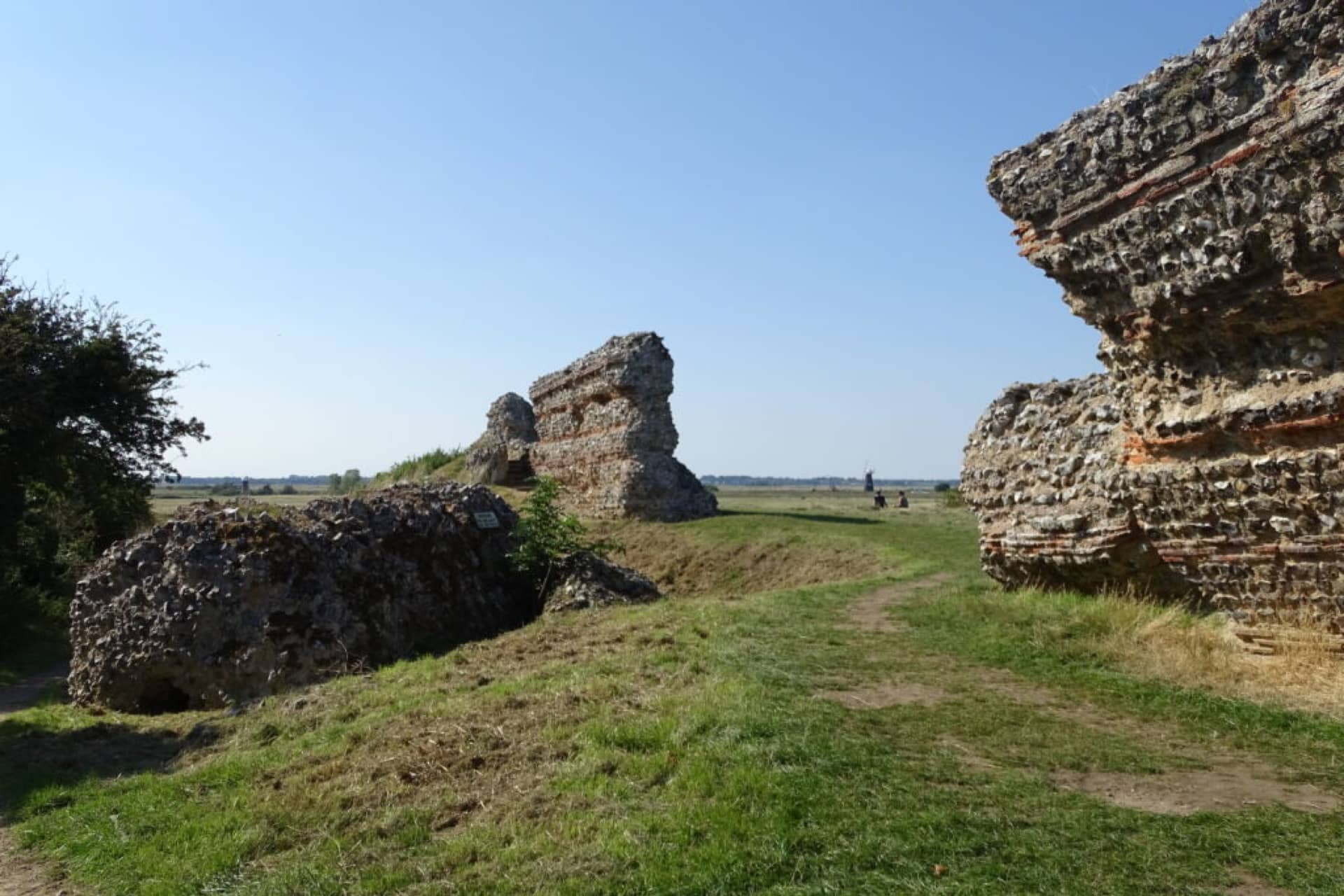
Burgh Castle
Take a walk into Roman Britain when the East Anglian coast was constantly threatened by merciless seaborne Saxon raiders. A string of defensive forts was constructed from the Solent to the Wash along what’s known today as the ‘Saxon Shore’. Burgh Castle was built in the late 3rd century, an impressive structure of flint and mortar rising from pastures next to Butt Lane, near Great Yarmouth. A Roman cavalry was housed here, and extensive cropmarks indicate there was once a significant ‘vicus’ (civilian settlement) surrounding the fort. In the 4th century AD Burgh and Caister controlled the entrance to the marshy Waveney estuary, probably operating together and known by the Romans as Gariannonum. It’s worth visiting Caister too, while you’re in the area.
At Burgh Castle, an English Heritage site, three imposing stone walls survive, towering at almost their original height, making this one of the best-preserved Roman monuments in Britain. The fourth wall has long since tumbled into the surrounding marshes dramatically framing a shimmering panorama of mud and salt marsh over Breydon Water.
The land around the fort is rich in wildlife, lovely for a wheelchair accessible circular walk (1.5 mile/2.5 km) starting at Fort car park on Butt Lane before heading to the pub. You might spot wigeon and plover and elusive roe and water deer roaming through whispering grasses. But look out! Raiders still stalk the Norfolk coast; ghostly barn owls sail low over the meadows, hunting their own plunder in this ancient land.

Tasburgh Hill Fort
A few miles south of Norwich, in the beautiful valley of the River Tas, there’s a mysterious earthworks. Who walked these fields long ago? Perhaps Boudica, East Anglia’s fierce warrior queen once strode the perimeter with rebellion on her mind. ‘Burgh’ means a ‘defended place’, while ‘taese’ is an Old English word meaning advantageous or pleasant. And Tasburgh is indeed a very pleasant place to wander, dreaming of the past.
Pottery found in the undulating ground tells of an Anglo-Saxon settlement around AD 700. It’s possible fortifications were built then, perhaps using a pre-existing enclosure, dating further back to the Iron Age. Excavations near the church revealed a low flint structure, so another theory is the earthworks were thrown up in turbulent 9th century times when marauding Viking Danes were wreaking havoc across East Anglia. By 1200 the settlement became more dispersed, developing away from the church. The old earthworks were quarried for materials and in some places ploughed flat by farmers levelling the land.
There’s a gem of a scene in the glorious East Anglian comedy The Detectorists where Mackenzie Crook finds and blows a hawker’s whistle, giving a small shiver as if that single note calls through centuries of time. (First episode, third series.) As he and Toby Jones head to the pub, Magpie by The Unthanks plays, and the summer evening dissolves into an ancient past. We walk in a land shaped by stories and true treasure is found in the tales we tell.

Thetford Castle
In the historic market town of Thetford stands the largest earthen motte in England. Climb 40 feet and 90 steep steps to the top to see for miles across Norfolk. Here, a Norman castle once dominated the town, erected inside an ancient Iron Age earthworks. Standing at the crossings of the rivers Thet and Ouse, the Iceni tribe hill fort, dating from around 500BC, oversaw Ickneild Way, ‘the oldest road in England’. The 4,000 year old trackway connects Dorset to Norfolk along the chalk spine of England, George R.R. Martin’s inspiration for the Kingsroad in Game of Thrones.
The Domesday Book notes Thetford was England’s sixth largest town a strategic site for a Norman motte and bailey castle, believed to have been constructed in 1067, immediately after the Norman Conquest. Topped by a wooden tower encircled by a timber palisade, the Norman castle was probably built by Ralph Guader, Earl of East Anglia until he led an unsuccessful Revolt of the Earls against the Crown 1076. Or by his successor Roger Bigod (Baron Bigod cheese is named after his lordly lineage).
Only Silbury Hill in Wiltshire has a larger human-made mound, and Thetford’s is just as rich in mystery and legend. Medieval locals called it Devil’s Dyke, formed by mud falling from Satan’s filthy hoof. Others claim a king’s palace, full of treasure, lies under the hill or that six silver bells from Thetford Priory were hidden here during the Reformation, still buried deep in Norfolk earth.
Build your own itinerary
If you fancy creating your own itinerary for a day trip to Norfolk or a longer visit, it couldn’t be simpler. Just go to Search Activities and select from our wide range of free and paid-for experiences, saving any that capture your imagination with the click of a button.
Once you’ve finished, you’ll find all the information stored in My Favourite, where you can drag and drop activities to create your own day-by-day itinerary! You can download this to a calendar and even share it with friends.
